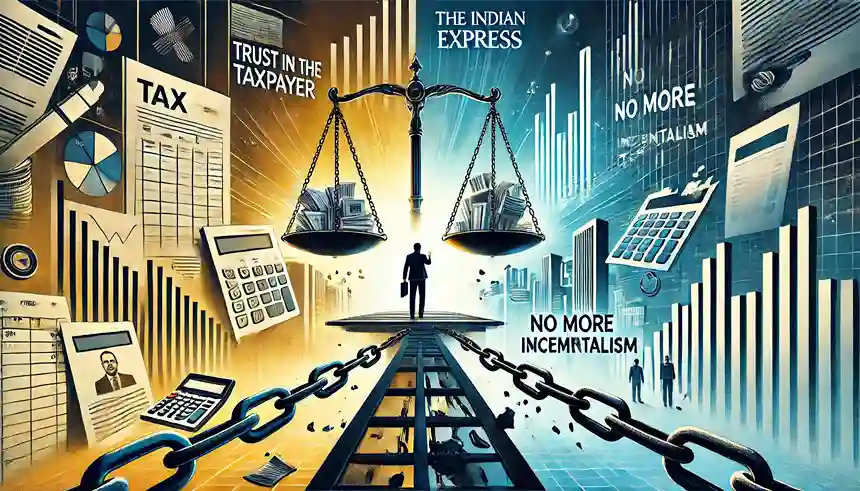Analysis of The Hindu Editorial 1: An approaching milestone in constitutional governance
Context
India stands on the brink of a remarkable milestone—75 years of constitutional governance. This anniversary is not only a moment of pride but also a time for reflection on the journey of democracy that has shaped the nation.
Introduction
On November 26, India will commemorate the 75th anniversary of the adoption of its Constitution. This day marks a significant event that calls for celebration from every corner of Indian society. Constitutional governance in India is more than just a set of legal frameworks or procedural norms; it embodies a rich culture of constitutional values that have deeply influenced the mindset of Indian citizens, transcending cultural, religious, and regional diversities. The legacy of these values has not only defined the nation but has also fostered a sense of unity amidst diversity.
- Analysis of The Indian Express Editorial – February 13, 2025

- Analysis of The Indian Express Editorial – February 12, 2025

- Analysis of The Indian Express Editorial – December 31, 2024

- Analysis of The Indian Express Editorial – December 19, 2024

- Analysis of The Indian Express Editorial – December 18, 2024

Respect for Democratic Institutions and Peaceful Power Transition
As India gears up to celebrate Constitution Day, it’s crucial to recognize the foundational values that have nurtured the nation’s constitutional culture. Among these, five values have been particularly enduring:
- Respect for Democratic Institutions: When the Indian Constitution was adopted in 1949, the life expectancy in the country was around 32 years. Today, that figure has doubled to around 70 years, reflecting significant improvements in the standard of living. This progress has reinforced the ordinary citizen’s respect for democratic processes and institutions.
- Economic and Social Progress: Over the decades, India’s development story has unfolded as a testament to effective public policies. This growth has enabled millions to better appreciate the role of democratic governance in improving their lives.
- Active Electoral Participation: A key feature of Indian democracy is the robust participation in elections, whether at the local, state, or national level. Indians consistently demonstrate their belief in democracy, expecting accountability and better performance from their elected leaders.
- Voter Turnout: Since the first elections in 1951-52, voter turnout has consistently hovered around 60%. The 2024 general election saw a notable turnout of 65.79%, emphasizing the ongoing faith in democratic processes.
- Enduring Faith in Democracy: Respect for the principles of democracy and a steadfast belief in democratic institutions remain at the heart of India’s political culture. These values have sustained the country’s democratic journey through many challenges.
Smooth Transitions of Power: A Hallmark of Indian Democracy
Over the past seven decades, India has witnessed numerous elections at both state and national levels. Political representation has come from a diverse range of parties, each contributing uniquely to the democratic fabric:
- Diverse Political Representation: India has seen leadership from a broad spectrum of ideologies, with different political parties and coalitions coming into power. This diversity underscores the dynamic nature of India’s democracy.
- Commitment to Peaceful Transitions: One of the most distinctive aspects of India’s democratic tradition is the strong commitment to smooth transitions of power. Despite intense election campaigns and, at times, divisive rhetoric, the outcome is a reaffirmation of the people’s will, highlighting the maturity of India’s electoral system.
- The Role of the Electorate: Indian voters have repeatedly shown their understanding of the nation’s challenges and their power to shape the country’s future through the ballot. Their participation ensures a seamless transition of power, reflecting the core value of democratic engagement.
- [PDF] “Arihant Computer Awareness Book 1” – Free Download
![[PDF] Arihant Computer Book.pdf” – Free Download for Competitive Exams](https://savepdf.in/wp-content/uploads/2025/04/PDF-Arihant-Computer-Book.pdf-–-Free-Download-for-Competitive-Exams-1040x650.webp)
- [PDF] The Pragmatic Programmer by David Thomas and Andrew Hunt

- [PDF] Structure and Interpretation of Computer Programs
![[PDF] Structure and Interpretation of Computer Programs](https://savepdf.in/wp-content/uploads/2024/12/PDF-Structure-and-Interpretation-of-Computer-Programs-1157x650.webp)
- [PDF] Computer Fundamentals by Anita Goel – Free Download
![[PDF] Computer Fundamentals by Anita Goel – Free Download](https://savepdf.in/wp-content/uploads/2024/11/Computer-FundameComputer-Fundamentals-by-Anita-GoelComputer-Fundamentals-by-Anita-Goelntals-by-Anita-Goel-1156x650.png)
- [PDF] – Mainframe Systems Programming: An Introduction – Download Now
![Mainframe Systems Programming: An Introduction – [PDF]](https://savepdf.in/wp-content/uploads/2024/10/PDF-–-Mainframe-Systems_20241004_162243_0000-1156x650.webp)
Protecting Rights: The Role of the Judiciary
- Importance of Fundamental Rights: The framers of the Indian Constitution placed a strong emphasis on safeguarding fundamental rights, entrusting the judiciary with the critical role of protecting citizens’ liberties.
- Legacy of the Constitution’s Framers: The architects of the Constitution, many of whom were key figures in the freedom movement, were acutely aware of the dangers of an unchecked state. Their experiences with colonial rule informed their commitment to a framework that balances state authority with individual freedoms.
- Judicial Vigilance: The Constitution’s emphasis on individual rights has been reinforced over the years through vigilant judicial oversight, making it clear that the protection of rights is non-negotiable in a democratic India.
Federalism: Embracing Diversity Within a Unified Framework
- Acknowledging Diversity: India’s Constitution acknowledges the nation’s extraordinary diversity, from linguistic variety to cultural pluralism. It strives to respect the unique identities of various states while promoting a unified national identity.
- Autonomy and Inclusivity: The Constitution offers special provisions to accommodate regional disparities and to ensure equitable development across the country. This approach has helped bridge gaps and promote inclusivity.
- Evolving Federalism: India’s federal structure has deepened over the decades, reflected in the rise of regional political parties and the formation of coalition governments. The 73rd and 74th Constitutional Amendments further decentralized power by empowering local self-governance through panchayats and municipalities.
The Role of Media and Civil Society in Democracy
- Media as a Democratic Pillar: The Indian media, with its varied voices across different languages and regions, has played a crucial role in shaping public opinion. Its evolution from print to digital and broadcast media has expanded access to information.
- Civil Society’s Influence: Despite challenges to its independence, the media, along with civil society organizations, has been instrumental in promoting transparency and accountability in governance.
- Navigating the Information Age: In the era of an information explosion, the Indian electorate has become more discerning, understanding the critical role media plays in shaping their perspectives on democracy.
Conclusion: A Celebration of India’s Constitutional Journey
India’s 75 years of constitutional governance is a testament to the strength and resilience of its democratic values. When India gained independence, many doubted its ability to maintain unity amidst vast diversity. Yet, the country has not only proven these skeptics wrong but has also built a robust national identity grounded in constitutional principles. The Constitution has evolved into a powerful instrument for social and political awakening, guiding India’s journey as a thriving democracy. As we celebrate this milestone, we acknowledge the profound role the Constitution has played in shaping a nation that upholds justice, equality, and liberty for all.
- [PDF] Kiran SSC 10600+ General Awareness Book English
![[PDF] Kiran SSC General Awareness Book English](https://savepdf.in/wp-content/uploads/2024/12/PDF-Kiran-SSC-10600-General-Awareness-Book-English-1156x650.webp)
- [PDF] – Manorama Yearbook 2025: A Comprehensive Guide to Knowledge and Exam Success

- [PDF] Blackbook 25000+ GA English Medium
![[PDF] Blackbook 25000+ GA English Medium](https://savepdf.in/wp-content/uploads/2024/11/PDF-Blackbook-25000-GA-English-Medium-1156x650.webp)
- [PDF] Reasoning Made Easy – Download Now
![[PDF] Reasoning Made Easy](https://savepdf.in/wp-content/uploads/2024/11/Reasoning-Made-Easy-1156x650.webp)
- [PDF] Police Recruitment Challenger – Download Now
![[PDF] Police Recruitment Challenger](https://savepdf.in/wp-content/uploads/2024/11/Police-Recruitment-Challenger-1156x650.webp)
Analysis of The Hindu Editorial 2: The law enacted by the European Union recently is a model worth following
Context
In both advanced and emerging economies, achieving sustainable development and inclusive growth requires targeted policy actions. As environmental challenges intensify, adopting comprehensive strategies becomes crucial. The European Union’s (EU) Nature Restoration Law (NRL) presents an innovative framework, offering valuable insights that India can adapt to address its own environmental crises.
Introduction
The rapid degradation of natural ecosystems is one of the most pressing global challenges, and India is not exempt. Nearly 30% of India’s total geographical area is affected by land degradation, highlighting an urgent need for comprehensive solutions. The Nature Restoration Law (NRL), recently enacted by the EU, serves as an inspiring blueprint for India to combat its environmental challenges. By studying this model, India can craft a tailored approach to restore its ecological balance.
Key Elements of the EU’s Nature Restoration Law (NRL)
The NRL, implemented by the EU’s Environmental Council on June 17, 2024, is a landmark legislation aimed at reviving Europe’s natural ecosystems. Here’s what makes it significant:
- Restoration Targets: The law mandates the restoration of at least 20% of the EU’s land and sea areas by 2030, with an ambitious goal of restoring all ecosystems requiring attention by 2050.
- Widespread Support: The legislation was backed by a majority of EU member states, representing 66.07% of the EU’s population, marking a collective commitment to environmental preservation.
- Focus Areas: The NRL targets diverse ecosystems, including forests, agricultural lands, rivers, and urban areas. Key initiatives include restoring 25,000 kilometers of rivers to their natural flow and planting three billion trees by 2030.
- Part of Broader Strategies: As a cornerstone of the EU’s Biodiversity Strategy for 2030 and the European Green Deal, the NRL aims to reverse the decline in biodiversity, addressing the fact that over 80% of Europe’s habitats are currently in poor condition.
Environmental Challenges in India
India faces a range of environmental challenges, many of which are as severe as those in Europe, if not more so:
| Challenge | Details |
|---|---|
| Land Degradation | As per ISRO’s Desertification and Land Degradation Atlas, 97.85 million hectares (29.7%) of India’s land was degraded in 2018-19, up from 94.53 million hectares in 2003-05. |
| Desertification | Affected around 83.69 million hectares in 2018-19, with major impacts in states like Gujarat, Karnataka, Maharashtra, and Rajasthan. |
| Water Resources and Pollution | Rivers like the Ganga and Yamuna suffer from pollution and reduced flow, exacerbating ecological damage. |
| Biodiversity Loss | Key regions such as the Sundarbans and other wetlands are under threat, impacting both wildlife and local communities. |
India’s Ongoing Efforts
India has made notable progress in addressing these environmental challenges through various initiatives:
- Green India Mission and Pradhan Mantri Krishi Sinchayee Yojana have aimed at improving forest cover and irrigation.
- Integrated Watershed Management Programme (one of the world’s largest) focuses on restoring degraded watersheds.
- National Afforestation Programme works to increase tree cover across the country.
While these efforts have had positive impacts, the scale of the problem necessitates a more structured and legally binding approach.
What a Nature Restoration Law in India Could Entail
Drawing inspiration from the EU’s NRL, a similar law tailored for India’s unique ecological landscape could include the following elements:
| Proposed Measure | Description |
|---|---|
| Ambitious Restoration Targets | Restore 20% of degraded land by 2030 and aim for complete restoration of critical ecosystems by 2050, including forests, rivers, and urban spaces. |
| Wetland Focus | Focus on restoring 30% of degraded wetlands like the Sundarbans and Chilika Lake by 2030 to support biodiversity and climate resilience. |
| Sustainable Agriculture | Promote agroforestry and sustainable farming practices to rejuvenate farmlands, using indicators like the butterfly or bird index to track progress. |
| River Revitalization | Prioritize the restoration of major rivers, beginning with the Ganga and Yamuna, to enhance water flow and reduce pollution. |
| Urban Green Spaces | Implement policies to prevent the loss of green spaces in cities and foster urban forests to mitigate the effects of heat islands and air pollution. |
Economic and Social Benefits of a Restoration Law
Adopting a comprehensive nature restoration law in India would bring a multitude of benefits beyond environmental improvements:
- Economic Boost: According to the World Economic Forum, nature restoration has the potential to generate global economic returns of up to $10 trillion annually by 2030. In India, restoring degraded lands can enhance agricultural yields, improve water availability, and create millions of job opportunities, especially in rural regions.
- Progress Toward Sustainable Development Goals (SDGs): A nature restoration law would support India’s progress toward SDG 15, which focuses on managing forests sustainably and combating desertification.
- Climate Change Mitigation: Healthy ecosystems act as carbon sinks, playing a crucial role in absorbing carbon dioxide. By restoring its degraded landscapes, India can bolster its carbon sequestration capacity, aiding in the fight against climate change and fulfilling its commitments under the Paris Agreement.
Conclusion
The European Union’s Nature Restoration Law is a pioneering step that sets a high standard for global environmental governance. As India confronts its own environmental challenges, the lessons from the EU model offer a valuable framework. By adopting a similar approach, India can not only restore its ecosystems but also unlock socio-economic growth and enhance its resilience to climate change. With the clock ticking on both environmental and developmental fronts, now is the time for India to take decisive action and secure a sustainable future for its people and the planet.

